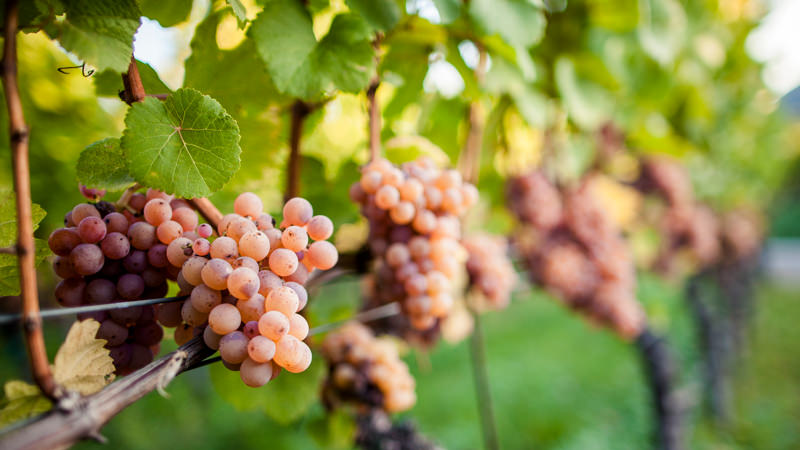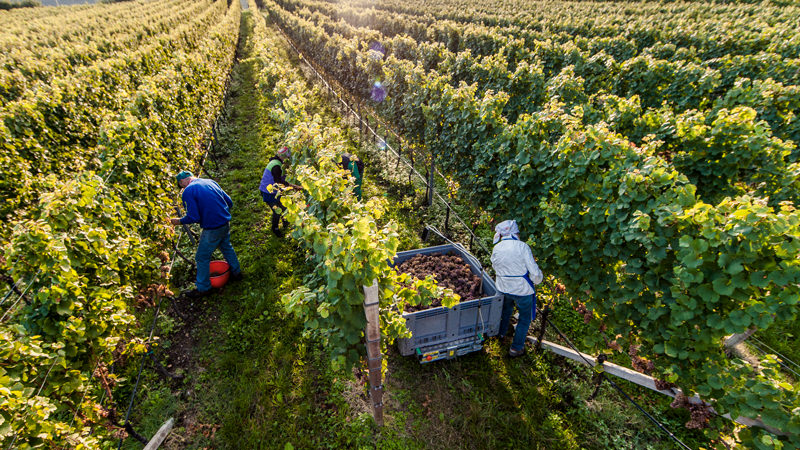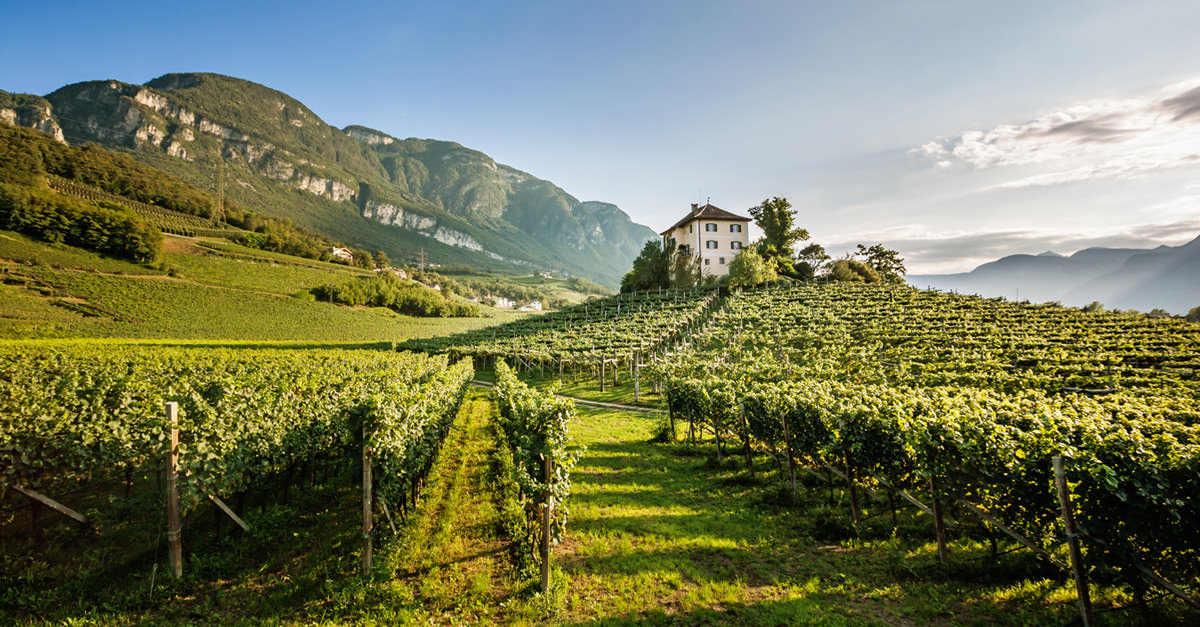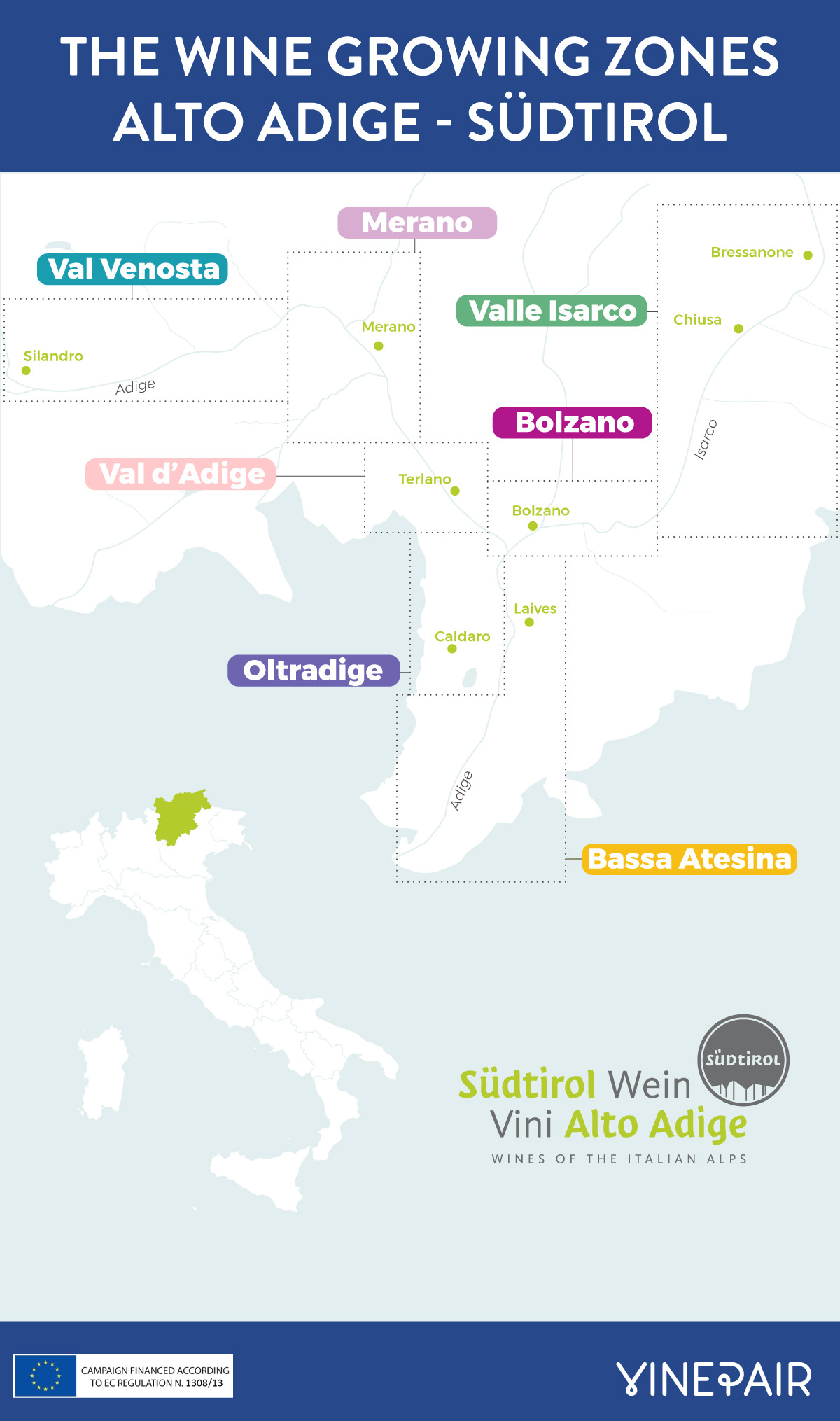Archetypal images of Italian wine regions showcase rolling vineyards interspersed with olive trees and warm, sunny climates. This is not Alto Adige – Südtirol. Backdropped by stunning, snow-capped mountains, this northerly region is more evocative of Austria than Tuscany, putting a twist on a typical Italian region.
While many wine professionals group Trentino-Alto Adige together as a single region, it’s far more accurate to distinguish Alto Adige – Südtirol, as its own area with distinct geography, climate, grape varieties, and styles of wine. Though it is one of Italy’s smallest, comprising just one percent of the country’s production, the region is known for having exceptionally high quality. 98 percent of Alto Adige – Südtirol’s wines are DOC quality, which is the most in Italy.
Discover the nuances of this unique northern Italian region, and you’ll be wondering why you haven’t been drinking these diverse Alpine wines all along.

What is the history of Alto Adige – Südtirol?
Located in the northernmost part of Italy (it borders Austria and Switzerland), Alto Adige – Südtirol was the main passageway between Italy and the rest of Europe for many years; this made the region highly desirable and it was often a place of conquest, being shuffled back and forth between countries and empires. For a long time it was part of the Austro-Hungarian Empire, and only became part of Italy after World War I, contributing to its unique culture and firmly distinguishes it from neighboring regions.
Most residents speak both Italian and German and two-thirds are native German speakers, hence the reason why the region is Alto Adige – Südtirol. Many wineries have names in both languages for the Cantina (Italian) or Kellerei (German), and wine labels could include a grape variety’s name in either language, such as Pinot Grigio or Grauburgunder. But despite its history of change, archaeological evidence places Alto Adige – Südtirol among the oldest winegrowing regions in Europe, dating back to the 5th century B.C.
What is the Climate and Geography of Alto Adige – Südtirol?
As is evident from any photo of Alto Adige – Südtirol, the biggest climatic and geographic influences on the region are the stunning Alps and Dolomites to the north. These mountains protect the region from cold winds and rain, giving the vineyards 300 sunny days each year. While the area has excellent diurnal shift — that large day-night swing in temperature that preserves acidity during cool nights — it can actually get quite warm, due to Mediterranean influences coming up from south. Interestingly, the capital city of Bolzano, also known as Bozen, is often hotter than Rome, and even southern Sicily, in the summertime.
Though Alto Adige – Südtirol winegrowing covers 13,300 acres of vineyards shaped in a rough “Y,” it is more diverse than one might assume. Because of the dramatic topography of mountain and valley vineyards, grapes are planted anywhere between 600 and 3,300 feet. High elevation vineyards planted on the slopes of the mountains are much cooler and well-suited to white grapes, while lower valley vineyards can fully ripen grapes like Lagrein and Merlot.
With over 5,000 growers, each tending to 2.66 acres on average, much of Alto Adige – Südtirol’s wine production is driven by large cooperatives. That doesn’t equate to uninteresting, bulk wine, however; some of the most highly-regarded wines in the region are produced by co-ops. The cooperatives of Alto Adige – Südtirol really focus on quality, bringing together several hundred small growers to produce about 70 percent of the region’s wines. The rest is produced by estate wineries and independent winegrowers.
What are the Wines and Grapes of Alto Adige – Südtirol?
While Alto Adige – Südtirol is known for being one of Italy’s top white wine producing regions, it makes excellent red wine as well. Vintners cultivate 20 different grape varieties to make a range of wines, typically 60 percent white and 40 percent red. The region boasts some interesting indigenous varieties and also produces some of the world’s top examples of international grapes such as Pinot Grigio and Pinot Nero, meaning that there’s something for everyone.
The White Grapes of Alto Adige – Südtirol
Pinot Grigio, also known as Grauburgunder or Rülander, is produced across Italy, but Alto Adige – Südtirol truly makes some of the country’s best examples. Bright and aromatic, balanced and complex, the region’s Pinot Grigio are an excellent bet if you’re seeking quality Pinot Grigio.
It’s easy to see why aromatic Gewürztraminer is often tied to Alto Adige – Südtirol, as many say that the grape originated near the local town of Termeno (Tramin in German). No matter its history, it’s safe to say some of the grape’s best iterations come from the region, where they are typically dry, well-balanced, and spicy (which “gewürz” translates to).
The fragrant, lesser-known Kerner and Sylvaner grapes are often found in higher-elevation vineyards, where they have excellent acidity and minerality. Chardonnay, Sauvignon Blanc, Müller-Thurgau, Moscato Giallo, Riesling, and Grüner Veltliner are also found in Alto Adige – Südtirol.

The Red Grapes of Alto Adige – Südtirol
Schiava, also called Vernatsch, is one of Alto Adige – Südtirol’s two indigenous red grapes, and if you’re a lover of light reds, you should get to know it immediately. Traditionally Schiava was the workhorse grape of the region and is still the most-planted (primarily pergola trained) red grape, but vintners and wine lovers alike have embraced it recently for its light, charming character. The wines are pale and low in tannins, with fresh red fruit flavors and acidity that pops when chilled slightly.
Pinot Nero, aka the ubiquitous Pinot Noir, really sings in Alto Adige – Südtirol where you can also find it labeled as its German name, Blauburgunder. The region’s cool, sunny climate produces lithe, fresh wines with plenty of fresh berry and floral aromas. Some winemakers choose to oak their Pinot Nero wines, while others let it express itself naturally.
Lagrein is Alto Adige – Südtirol’s other native red variety and centers around its home of Bolzano (Bozen), where it is known for having deeper color and more complexity than Schiava. Though in a world landscape Lagrein tends to be a medium-bodied wine, it is fuller than other regional reds and is often paired with heavier fare. Look for flavors of mixed berries, violets, and spice.
Other, richer red grapes like Cabernet Sauvignon and Merlot are also planted but often take second seat to the region’s light to medium-bodied specialties.
What are the Winegrowing Zones of Alto Adige – Südtirol?
The varied topography of Alto Adige – Südtirol can be broken up into seven main winegrowing zones. Climate and soil changes dramatically from the warm, southern reaches of Bassa Atesina to the cool, steep vineyards of Valle Isarco. Any white, red, rosé, or sparkling wine from the region that meets quality requirements can qualify as Alto Adige – Südtirol DOC. In addition to this main DOC, there are other classifications that designate wines reflective of one of the specific growing areas, below.
Bassa Atesina: The largest winegrowing zone in Alto Adige – Südtirol at 4,655 acres, grapevines thrive at altitudes as high as 3,300 feet above sea level and as low as 600 feet in the southernmost areas of the zone. Here you’ll find mostly white wines such as Pinot Grigio, Chardonnay, and what some say to be the truest expression of Gewürztraminer.
Oltradige: Known as the heart of Alto Adige – Südtirol with its iconic Lake Caldaro (or Kaltern), Oltradige is the second largest winegrowing zone of the region and home to many different varieties. While white wine accounts for the majority of production over its 4,309 acres, winemakers are making great expressions of Schiava, Pinot Bianco, Chardonnay, Merlot, and Cabernet Sauvignon.
Bolzano: Temperatures can get pretty high in the Bolzano wine growing zone, peaking out at 104 degrees Fahrenheit across it’s 1,675 acres. Here you’ll find red wines from the Schiava grape, especially in the Santa Maddalena and Lagrein.
Val d’Adige: Nestled in the Central Adige Valley between Bolzano and Merano, Val d’Adige’s soil requires the vines to grow deep roots to receive water, forming the foundation of their mineral-rich and beautifully structured Pinot Biancos.
Merano: In the northwestern part of Alto Adige – Südtirol, temperatures are milder, and there is sandy soil. Red grapes like Schiava and Pinot Nero often garner good acidity making for strong ageability.
Val Venosta: Originally known for beautiful apple orchards, Val Venosta has become a major winegrowing region in Alto Adige – Südtirol with 128 acres of vineyards. Here, red and white grapes intermingle with apple orchards, and sandy soils and lower rainfall make for delicate, finely-structured wines.
Isarco Valley: This is the northernmost growing zone within Alto Adige – Südtirol, climbing up mountain slopes in the northeastern arm of the region. Wines are almost always white, made from grapes like Sylvaner, Kerner, and Müller-Thurgau in fresh, aromatic styles.


